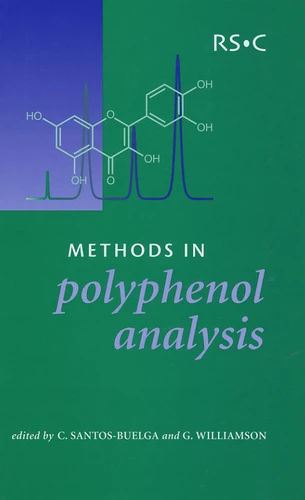Methods in Polyphenol Analysis
Par : ,Formats :
- Paiement en ligne :
- Livraison à domicile ou en point Mondial Relay indisponible
- Retrait Click and Collect en magasin gratuit
- Nombre de pages383
- PrésentationRelié
- FormatGrand Format
- Poids0.74 kg
- Dimensions16,0 cm × 24,0 cm × 3,0 cm
- ISBN0-85404-580-5
- EAN9780854045808
- Date de parution01/04/2003
- ÉditeurRoyal Society of Chemistry
Résumé
Polyphenols make a vital contribution to the colour, tanning, taste and astringency of so many of society's favourites — from the unique taste of the British cup of tea to a glass of red wine. Found widely in many foods of plant origin, polyphenols are also becoming increasingly recognised as antioxidants in the body, with action on long-term health and reduction in the risk of chronic disease. Due to the importance of polyphenols, it is vital to conduct accurate and sensitive analysis.
Providing detailed state-of-the-art research, presented in a practical and effective way, Methods in Polyphenol Analysis looks at the latest techniques in this developing field and includes, among others : New modern techniques, such as LC-MS, LC-NMR and LC-coulometric detection. Chemical and enzymatic synthesis of polyphenol conjugates. Characterization of oligomeric and polymerictannins and complex polyphenols.
This timely publication is written by highly experienced practitioners in this field and will be invaluable to all academics and industrialists involved in phytochem-istry, biochemistry and food science.
Providing detailed state-of-the-art research, presented in a practical and effective way, Methods in Polyphenol Analysis looks at the latest techniques in this developing field and includes, among others : New modern techniques, such as LC-MS, LC-NMR and LC-coulometric detection. Chemical and enzymatic synthesis of polyphenol conjugates. Characterization of oligomeric and polymerictannins and complex polyphenols.
This timely publication is written by highly experienced practitioners in this field and will be invaluable to all academics and industrialists involved in phytochem-istry, biochemistry and food science.
Polyphenols make a vital contribution to the colour, tanning, taste and astringency of so many of society's favourites — from the unique taste of the British cup of tea to a glass of red wine. Found widely in many foods of plant origin, polyphenols are also becoming increasingly recognised as antioxidants in the body, with action on long-term health and reduction in the risk of chronic disease. Due to the importance of polyphenols, it is vital to conduct accurate and sensitive analysis.
Providing detailed state-of-the-art research, presented in a practical and effective way, Methods in Polyphenol Analysis looks at the latest techniques in this developing field and includes, among others : New modern techniques, such as LC-MS, LC-NMR and LC-coulometric detection. Chemical and enzymatic synthesis of polyphenol conjugates. Characterization of oligomeric and polymerictannins and complex polyphenols.
This timely publication is written by highly experienced practitioners in this field and will be invaluable to all academics and industrialists involved in phytochem-istry, biochemistry and food science.
Providing detailed state-of-the-art research, presented in a practical and effective way, Methods in Polyphenol Analysis looks at the latest techniques in this developing field and includes, among others : New modern techniques, such as LC-MS, LC-NMR and LC-coulometric detection. Chemical and enzymatic synthesis of polyphenol conjugates. Characterization of oligomeric and polymerictannins and complex polyphenols.
This timely publication is written by highly experienced practitioners in this field and will be invaluable to all academics and industrialists involved in phytochem-istry, biochemistry and food science.


